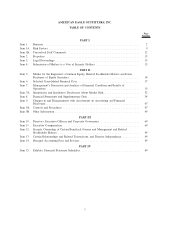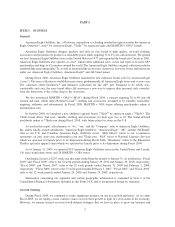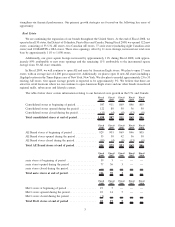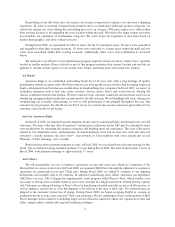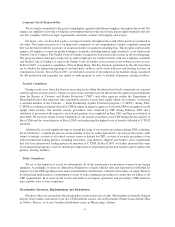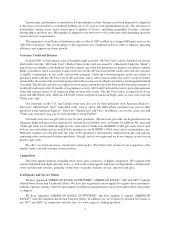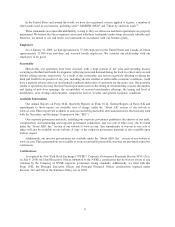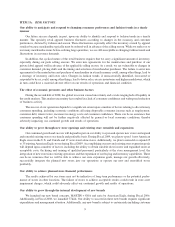American Eagle Outfitters 2008 Annual Report Download - page 8
Download and view the complete annual report
Please find page 8 of the 2008 American Eagle Outfitters annual report below. You can navigate through the pages in the report by either clicking on the pages listed below, or by using the keyword search tool below to find specific information within the annual report.Corporate Social Responsibility
We are firmly committed to the goal of using highly regarded and efficient suppliers throughout the world. We
require our suppliers to provide a workplace environment that not only meets basic human rights standards, but also
one that complies with local legal requirements and treats workers with dignity and respect.
For many years, we have had a policy to inspect factories throughout the world where goods are produced to
our order. This inspection process is an important component of our comprehensive vendor compliance program
that was developed with the assistance of an internationally recognized consulting firm. This program contractually
requires all suppliers to meet our global workplace standards, including human rights standards, as set forth in our
Vendor Code of Conduct. The Vendor Code of Conduct is required to be posted in all factories in the local language.
The program utilizes third party inspectors to audit compliance by vendor factories with our workplace standards
and Vendor Code of Conduct. A copy of the Vendor Code of Conduct is also posted on our website at www.ae.com.
In Fiscal 2007, we opened a compliance office in Hong Kong. The key functions performed by the AE team there
are to validate the inspection reporting of our third-party auditors, and to work with new and existing factories on
remediation of issues. Also in Fiscal 2007, we instituted a process of pre-inspection for facilities being considered
for AE production and expanded our annual re-audit program to strive to include all primary existing facilities.
Security Compliance
During recent years, there has been an increasing focus within the international trade community on concerns
related to global terrorist activity. Various security issues and other terrorist threats have brought increased demands
from the Bureau of Customs and Border Protection (“CBP”) and other agencies within the Department of
Homeland Security that importers take responsible action to secure their supply chains. In response, we became
a certified member of the Customs — Trade Partnership Against Terrorism program (“C-TPAT”) during 2004.
C-TPAT is a voluntary program offered by CBP in which an importer agrees to work with CBP to strengthen overall
supply chain security. Our internal security procedures were reviewed by CBP during February 2005 and a
validation of processes with respect to our external partners was completed in June 2005 and then re-evaluated in
June 2008. We received formal written validations of our security procedures from CBP during the first quarter of
Fiscal 2006 and the second quarter of Fiscal 2008, each indicating the highest level of benefits afforded to C-TPAT
members.
Additionally, we took significant steps to expand the scope of our security procedures during 2004, including,
but not limited to: a significant increase in the number of factory audits performed; a revision of the factory audit
format to include a review of all critical security issues as defined by CBP; a review of security procedures of our
other international trading partners, including forwarders, consolidators, shippers and brokers; and a requirement
that all of our international trading partners be members of C-TPAT. In Fiscal 2007, we further increased the scope
of our inspection program to strive to include pre-inspections of all potential production facilities and re-audits of all
primary existing facilities.
Trade Compliance
We act as the importer of record for substantially all of the merchandise we purchase overseas from foreign
suppliers. Accordingly, we have an affirmative obligation to comply with the rules and regulations established for
importers by the CBP regarding issues such as merchandise classification, valuation and country of origin. We have
developed and implemented a comprehensive series of trade compliance procedures to assure that we adhere to all
CBP requirements. In its most recent review and audit of our import operations and procedures, CBP found no
unacceptable risks of non-compliance.
Merchandise Inventory, Replenishment and Distribution
Purchase orders are entered into the merchandise system at the time of order. Merchandise is normally shipped
directly from vendors and routed to our two US distribution centers, one in Warrendale, Pennsylvania and the other
in Ottawa, Kansas, or to our Canadian distribution center in Mississauga, Ontario.
6



